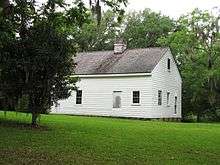Hampton Plantation
|
Hampton Plantation | |
|
Hampton Plantation House in 2010 | |
| Nearest city | McClellanville, South Carolina |
|---|---|
| Coordinates | 33°11′54″N 79°26′16″W / 33.19833°N 79.43778°WCoordinates: 33°11′54″N 79°26′16″W / 33.19833°N 79.43778°W |
| Built | 1730 |
| Architectural style | Georgian |
| NRHP Reference # | 70000582 |
| Significant dates | |
| Added to NRHP | April 15, 1970[1] |
| Designated NHL | April 15, 1970[2] |
Hampton Plantation, also known as Hampton Plantation House and Hampton Plantation State Historic Site, is a historic plantation, now a state historic site, north of McClellanville, South Carolina. The plantation was established in 1735, and its main house exhibits one of the earliest known examples in the United States of a temple front in domestic architecture. It is also one of the state's finest examples of a wood frame Georgian plantation house. It was declared a National Historic Landmark in 1970.[2][3]
Description and history
Hampton Plantation today consists of just under 300 acres (120 ha) of land on the banks of Hampton Creek, a tributary of the Santee River in northern Charleston County, South Carolina, west of United States Route 17. Most of the plantation land is no longer in agricultural use, and has reverted to natural wooded and swampy conditions. The main house, set near Hampton Creek, is a large 2-1/2 story wood frame structure, with a dormered hip roof, clapboard siding, and a raised brick foundation. Its most prominent exterior feature is a projecting temple front, with eight Doric columns (six across and two additional on the sides) supporting a decoratively carved Adamesque frieze and pedimented gable. This feature, added in 1790-91, is believed to be the first of its type in the United States.[3]

The house has an evolutionary construction history, begun in 1735 and ending roughly in 1790-91. The original core of the house was built in 1735 by Noe Serre, a French Huguenot refugee, and was a central-hall two-story structure. The property was acquired in 1757 by Daniel Horry, who greatly expanded the building, adding a two-story ballroom on one side, and a master bedroom suite on the other. In order to ensure symmetry of appearance, Horry had false shuttered windows placed on the front walls of these additions. The front portico is the last major alteration made to the building.[3] The Horrys, along with later owners from the Pinckney and Rutledge families, were all from politically and economically prominent South Carolina families. The last private owner the property was Archibald Rutledge, the state's first poet laureate. The property was acquired by the state in 1971.
See also
| Wikimedia Commons has media related to Hampton Plantation. |
- List of National Historic Landmarks in South Carolina
- National Register of Historic Places listings in Charleston County, South Carolina
References
- ↑ National Park Service (2007-01-23). "National Register Information System". National Register of Historic Places. National Park Service.
- 1 2 "Hampton Plantation". National Historic Landmark summary listing. National Park Service. Retrieved 2008-03-07.
- 1 2 3 James Dillon (April 1, 1976). "National Register of Historic Places Inventory-Nomination: Hampton Plantation" (pdf). National Park Service. and Accompanying five photos, exterior, from 1969 and 1975 (32 KB)
External links
- Official website
- Hampton Plantation, Charleston County (McClellanville vicinity), at South Carolina Department of Archives and History
- Historic American Buildings Survey (HABS) No. SC-72, "Hampton Plantation, Wambaw Creek, South side, McClellanville vicinity, Charleston County, SC", 14 photos, 2 data pages, 1 photo caption page, supplemental material


